Queen’s Team Demonstrates New Method for Particle Acceleration Using Ultraintense Lasers
Queen’s research published in Physical Review Letters highlights breakthrough in surface wave acceleration.

A research team led by School of Maths and Physics at Queen’s University Belfast has published new findings on surface wave acceleration in Physical Review Letters. The paper, authored by Dr Adrian McCay as lead researcher, has been selected as an Editor’s Recommendation and is also highlighted in Physics magazine of the American Physical Society.
The study reports the first experimental observation of super-ponderomotive electron beams accelerated by surface plasma waves excited on flat targets. These targets were irradiated at parallel incidence by the GEMINI laser at the Central Laser Facility of the Rutherford Appleton Laboratory (STFC).
Traditionally, exciting surface plasma waves has required complex nanostructures, which are difficult to manufacture and can introduce energy losses. This research demonstrates that ultraintense lasers can instead drive high-amplitude surface plasma waves on flat foils, removing the need for complex designs and opening new possibilities for charged-particle acceleration and light generation.
The work was carried out in collaboration with colleagues from École Polytechnique, CNR_INO, ELI Beamlines Facility, Central Laser Facility, and HB11 Energy.
Looking ahead, the team intends to develop the technique further, with a particular focus on proton acceleration - an application first proposed for this experimental geometry.
Media
For enquiries please contact Daria Pudovkina at: d.pudovkina@qub.ac.uk
